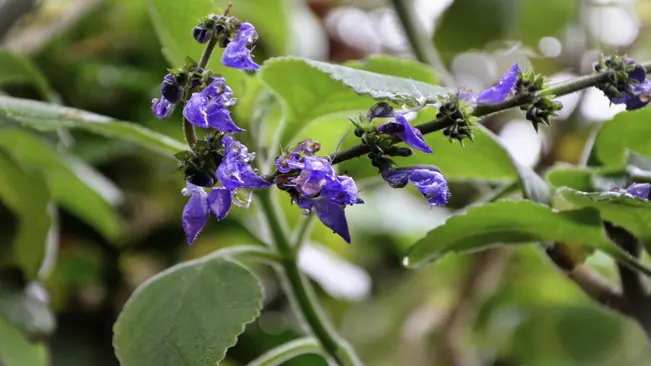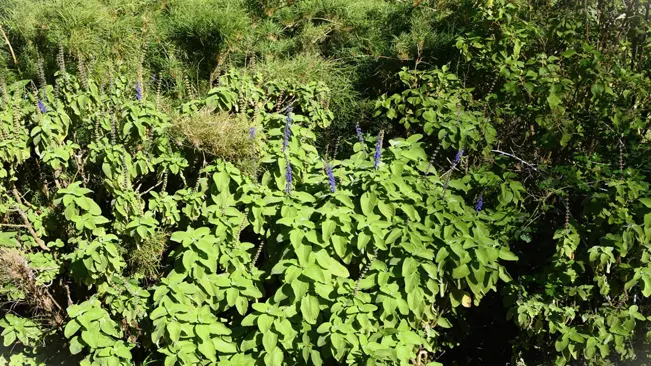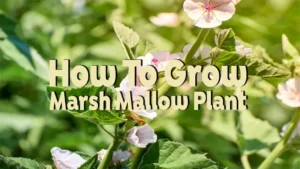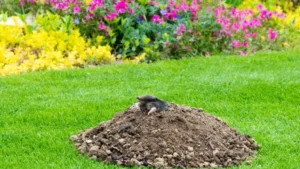How to Blue Spur Flower: Tips for a Flourishing Garden
- March 6, 2024
- 0 comment
The blue spur flower, scientifically known as Plectranthus barbatus, is a perennial herb known for its striking blue flowers and lush foliage. Often used in gardens for its decorative appeal and sometimes for its medicinal properties, this plant can be a captivating addition to your landscape. This article provides a comprehensive guide on how to successfully cultivate blue spur flowers in your garden.

Choosing the Right Location
Sunlight and Shade
Blue Spur Flowers, scientifically known as Plectranthus barbatus, exhibit a preference for a specific balance of light and shade, which is critical for their optimal growth and flowering:

- Partial Sunlight: These plants enjoy partial sunlight, which typically means they should receive direct sunlight for only a part of the day. Morning sunlight is generally softer and less intense compared to the harsh afternoon sun. Therefore, a location where the plants are exposed to the morning sun and protected from the intense afternoon sun is ideal.
- Partial Shade: In the afternoon, when the sun is at its peak, Blue Spur Flowers benefit from shade. This partial shade during the hottest part of the day helps in preventing the leaves from wilting or getting scorched.
- Adaptability to Full Sun: While they prefer partial sun, Blue Spur Flowers can adapt to full sun conditions, provided they are adequately watered and the climate is not excessively hot. In regions with strong sunlight, some type of afternoon shade or light filtering is beneficial.
Soil Conditions
The right soil condition is just as crucial as the correct lighting for the health and growth of Blue Spur Flowers:
- Well-Draining Soil: Good drainage is paramount. These plants do not fare well in waterlogged conditions, which can lead to root rot and other fungal diseases. Ensuring that the soil does not retain excess water will keep the roots healthy.
- Soil pH: Blue Spur Flowers prefer a slightly acidic to neutral soil pH, typically between 6.0 and 7.0. This pH range is conducive to nutrient absorption, crucial for healthy plant growth.
- Organic Matter: Enriching the soil with organic matter such as compost not only improves soil fertility but also enhances its structure and drainage capacity. Organic matter can provide essential nutrients to the plant, and its decomposition over time helps maintain soil health.
- Mulching: Adding a layer of mulch can help in retaining soil moisture, regulating soil temperature, and reducing weed growth. Organic mulches, like wood chips or straw, can also contribute to the soil’s nutrient content as they decompose.
Planting
When to Plant
The timing of planting Blue Spur Flowers is crucial for their successful growth. Springtime, specifically after the last frost, is ideal. The significance of this timing lies in the fact that Blue Spur Flowers, like many perennials, need time to establish their root system before they face the stresses of winter. Planting after the frost ensures that the young plants won’t be damaged by sudden cold spells. Additionally, the increasing temperatures and longer daylight hours in spring provide an optimal environment for growth.
Preparing for Planting
- Soil Preparation: Before planting, it’s important to prepare the soil. Loosen the soil to a depth of about 12-15 inches and mix in compost or other organic matter. This improves drainage and provides essential nutrients.
- Choosing the Right Spot: Remember that the plant thrives in partial sun and shade. A spot that gets morning sunlight and shade in the afternoon is ideal.
Planting Technique
- Digging the Hole: When digging the hole for the plant, ensure it’s about twice the width of the root ball. This gives the roots enough space to spread out and establish themselves.
- Root Ball Handling: Carefully remove the plant from its container. If the roots are tightly bound, gently tease them apart to encourage outward growth.
- Planting Depth: Place the plant in the hole at the same depth it was growing in its pot. Planting too deep can stress the plant and slow its growth.
- Backfilling the Hole: Fill the hole with soil, gently firming it around the roots to eliminate air pockets. Ensure the plant is upright and stable.
- Watering After Planting: Water the plant generously right after planting. This helps settle the soil around the roots and eliminates further air pockets. Continue to water regularly, especially during the initial growth phase.
Watering
Blue Spur Flowers prefer a consistent level of soil moisture. Their watering needs can be influenced by various factors such as climate, soil type, and the plant’s stage of growth.
- Climate Influence: In hotter climates or during dry, windy conditions, Blue Spur Flowers may need more frequent watering to maintain soil moisture. Conversely, in cooler or overcast conditions, they require less frequent watering.
- Soil Type: Soil that drains well is ideal for Blue Spur Flowers. Sandy soils may require more frequent watering as they drain quickly, whereas clay soils retain moisture longer and may need less frequent watering.
- Plant Growth Stage: Young plants or newly transplanted Blue Spur Flowers need more consistent moisture to help establish roots. Mature plants, with a well-developed root system, can tolerate short periods of dryness better.
Watering Techniques
- Check Soil Moisture: Before watering, check the soil moisture by sticking your finger about an inch into the soil. If it feels dry at that depth, it’s time to water.
- Watering Depth and Frequency: When watering, do so deeply enough to moisten the root zone. The frequency of watering will depend on the factors mentioned above, but as a general rule, allowing the top inch of soil to dry out between waterings is a good practice.
- Time of Day: Water early in the morning or late in the afternoon to reduce water loss due to evaporation. Avoid watering in the evening as this can lead to damp conditions overnight, which might promote fungal growth.
- Method of Watering: Use a watering can or hose to water at the base of the plant, avoiding overhead watering. This method helps keep the foliage dry and reduces the risk of leaf diseases.
Overwatering and Underwatering Signs
- Overwatering: Leaves may turn yellow, and the plant may look wilted despite the wet soil. Root rot is a common problem with overwatering, indicated by a foul smell from the soil and black or brown mushy roots.
- Underwatering: The plant will show signs of drought stress, like drooping leaves and dry, crispy leaf edges.
Fertilizing
Fertilization is a key aspect of nurturing healthy and vibrant Blue Spur Flowers. It provides essential nutrients that the soil may lack, supporting the plant’s growth, flowering potential, and overall health.
Choice of Fertilizer
- Balanced Fertilizer: A balanced, water-soluble fertilizer typically has equal parts of the primary nutrients: nitrogen (N), phosphorus (P), and potassium (K). For instance, a 10-10-10 or 20-20-20 formula is considered balanced.
- Nitrogen: Promotes healthy foliage growth.
- Phosphorus: Encourages root development and blooming.
- Potassium: Supports overall plant health and resistance to disease.
Fertilizing Schedule
- Growing Season (Spring and Summer): This is when the plant is actively growing and flowering. Fertilize once a month with the balanced, water-soluble fertilizer. Dilute the fertilizer according to the instructions on the package to avoid over-fertilization, which can harm the plant.
- Winter Months: Growth slows down during the colder months. Reduce the frequency of fertilization to prevent nutrient overload. You can either stop fertilizing altogether or reduce it to once every two months, depending on the plant’s response and your local climate.
Application Tips
- Dilution: Always dilute the fertilizer as per the instructions. Over-concentration can burn the roots and damage the plant.
- Even Distribution: Apply the fertilizer evenly around the base of the plant, ensuring it covers the area where the roots spread.
- Watering Before Fertilizing: It’s a good practice to water the plant before applying a water-soluble fertilizer. This prevents root burn and ensures better nutrient absorption.
- Avoiding Foliage: Try to avoid getting fertilizer directly on the leaves, as this can cause burns or spots.
Pruning and Maintenance
Why Prune?
Pruning Blue Spur Flowers is not just about maintaining their aesthetic appeal. It’s crucial for the health and vigor of the plant. By pruning, you encourage new growth, improve air circulation within the plant, and can control its shape and size.
When to Prune
The best time for pruning is in the early spring as the plant begins its active growth phase. This timing allows the plant to recover quickly and put its energy into new growth.
How to Prune
- Identify Old and Leggy Stems: Look for stems that are overextended, weak, or have stopped producing leaves and flowers.
- Use the Right Tools: A pair of sharp, clean pruning shears is essential. This prevents damage to the plant and reduces the risk of disease.
- Cutting Technique: Cut the stems at a 45-degree angle about 1/4 inch above a leaf node (the point on the stem where leaves emerge). This encourages the plant to produce two new growing points from the node, leading to bushier growth.
- Deadheading: Regularly remove spent flowers (deadheading). This not only keeps the plant looking tidy but also stimulates it to produce more blooms.
Pest and Disease Control
Common Pests
- Aphids and Spider Mites: These small pests can cause significant damage by sucking sap from the leaves, leading to discoloration and deformity.
Control Methods
- Regular Inspection: Regularly check the underside of leaves and stems for signs of pests.
- Insecticidal Soap or Neem Oil: These natural products are effective against a wide range of pests. Apply according to the product instructions, usually as a spray, ensuring you cover all parts of the plant.
- Water Spray: A strong jet of water can help dislodge pests like aphids.
Preventing Fungal Diseases
- Fungal diseases often result from excessive moisture on the leaves and poor air circulation.
- Watering Technique: Water at the base of the plant to avoid wetting the foliage. Overhead watering can leave moisture on the leaves, which encourages fungal growth.
- Air Circulation: Ensure plants are spaced appropriately and pruned to allow air to circulate freely. This helps leaves dry more quickly and reduces fungal spore accumulation.
- Cleanliness: Keep the area around the plants free of debris and fallen leaves. This reduces the habitat for pests and disease.
Propagation
Propagating blue spur flowers is relatively easy. You can do this by cuttings in the summer. Simply cut a stem, remove the lower leaves, and plant it in moist soil. The cuttings will root in a few weeks.
Choosing the Right Cutting
- Timing: The best time to take cuttings for propagation is during the summer when the plant is actively growing.
- Selecting Stem Cuttings: Choose healthy, non-flowering stems for the best results. The cuttings should be about 4 to 6 inches long.
Preparing the Cuttings
- Cutting: Use a sharp, clean pair of scissors or pruning shears to make a clean cut. An angled cut increases the surface area for rooting.
- Leaf Removal: Carefully remove the lower leaves from the cutting, leaving a few leaves at the top. This reduces moisture loss and focuses the plant’s energy on root development.
Rooting the Cuttings
- Rooting Medium: Plant the cutting in a well-draining potting mix. Some gardeners prefer using a mix of peat and perlite or sand for better drainage.
- Moisture and Humidity: Keep the soil consistently moist but not waterlogged. Covering the pot with a plastic bag or placing it in a mini greenhouse can help maintain high humidity, which is beneficial for root development.
- Light: Place the cuttings in a location with indirect sunlight. Too much direct sunlight can stress the cuttings.
Monitoring and Transplanting
- Root Development: In a few weeks, roots should start forming. You can gently tug on the cutting to feel if there’s resistance, indicating root growth.
- Transplanting: Once the cuttings have established a good root system, you can transplant them to individual pots or directly into the garden.
Conclusion
Growing blue spur flowers can be a rewarding experience for any gardener. By providing the right conditions and care, you can enjoy the vibrant blue blooms and lush foliage of this enchanting plant. Whether you are an experienced gardener or a novice, following these guidelines will help you successfully grow and maintain beautiful blue spur flowers in your garden.
FAQs (Frequently Asked Questions)
- What is the ideal location to plant Blue Spur Flowers?
- Blue Spur Flowers thrive in partial sunlight and shade. They prefer a spot that gets morning sunlight and is shaded in the afternoon.
- Blue Spur Flowers thrive in partial sunlight and shade. They prefer a spot that gets morning sunlight and is shaded in the afternoon.
- What type of soil is best for Blue Spur Flowers?
- They flourish in well-draining soil that is slightly acidic to neutral (pH 6.0 to 7.0). Enriching the soil with organic matter like compost can be beneficial.
- They flourish in well-draining soil that is slightly acidic to neutral (pH 6.0 to 7.0). Enriching the soil with organic matter like compost can be beneficial.
- How often should I water Blue Spur Flowers?
- Regular watering is crucial, especially during dry periods. Keep the soil consistently moist but avoid overwatering to prevent root rot.
- Regular watering is crucial, especially during dry periods. Keep the soil consistently moist but avoid overwatering to prevent root rot.
- Do Blue Spur Flowers need fertilization?
- Yes, fertilize them once a month during the growing season with a balanced, water-soluble fertilizer. Reduce feeding during winter.
- Yes, fertilize them once a month during the growing season with a balanced, water-soluble fertilizer. Reduce feeding during winter.
- How do I propagate Blue Spur Flowers?
- Propagation can be done through stem cuttings in the summer. Remove the lower leaves from a stem cutting and plant it in moist soil.
- Propagation can be done through stem cuttings in the summer. Remove the lower leaves from a stem cutting and plant it in moist soil.
- When is the best time to plant Blue Spur Flowers?
- The ideal time to plant them is in the spring, after the threat of frost has passed.
- The ideal time to plant them is in the spring, after the threat of frost has passed.
- Are Blue Spur Flowers prone to any pests or diseases?
- They can be susceptible to pests like aphids and spider mites. Use insecticidal soap or neem oil for control. Prevent fungal diseases by ensuring good air circulation.
- They can be susceptible to pests like aphids and spider mites. Use insecticidal soap or neem oil for control. Prevent fungal diseases by ensuring good air circulation.
- How do I prune Blue Spur Flowers?
- Trim back leggy stems in the spring and deadhead spent flowers to promote more blooming and a bushier growth.
- Trim back leggy stems in the spring and deadhead spent flowers to promote more blooming and a bushier growth.
- Can Blue Spur Flowers handle full sun?
- While they can tolerate full sun, too much direct sunlight might lead to leaf wilt. Partial sunlight is ideal.
- While they can tolerate full sun, too much direct sunlight might lead to leaf wilt. Partial sunlight is ideal.
- How tall do Blue Spur Flowers grow?
- Blue Spur Flowers can reach up to 2 to 3 feet in height, depending on the growing conditions and care they receive.

Kristine Moore
Forestry AuthorI'm Kristine Moore, a seasoned garden landscaping professional with over 30 years of experience. My extensive career has been dedicated to transforming outdoor spaces into stunning, sustainable landscapes. With a deep understanding of horticulture, design principles, and environmental stewardship, I have become a respected figure in the field, known for creating harmonious, visually appealing, and eco-friendly gardens. My commitment to excellence and continuous learning in landscaping trends and techniques has solidified my reputation as an expert in garden design and implementation.













Leave your comment